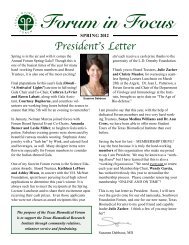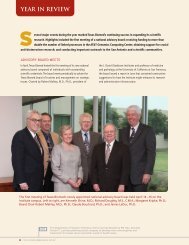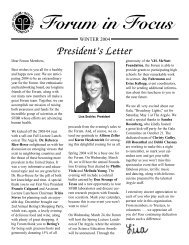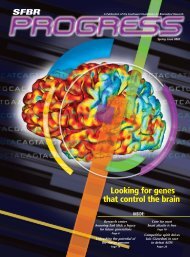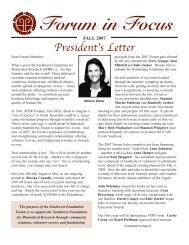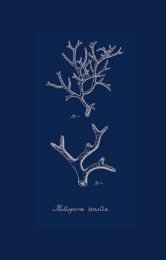Texas Biomed Science Report 2011-2012 - Texas Biomedical ...
Texas Biomed Science Report 2011-2012 - Texas Biomedical ...
Texas Biomed Science Report 2011-2012 - Texas Biomedical ...
You also want an ePaper? Increase the reach of your titles
YUMPU automatically turns print PDFs into web optimized ePapers that Google loves.
Southwest National<br />
Primate Research Center<br />
O<br />
n June 1, 1999, the Southwest National Primate Research<br />
Center (SNPRC) became the first new NCRR-funded National<br />
Primate Research Center (NPRC) established since the early 1960s.<br />
The SNPRC brought a number of unique strengths to the NPRC<br />
program, stemming from a long, productive history of nonhuman<br />
primate research at its host institution, the <strong>Texas</strong> <strong>Biomed</strong>ical Research<br />
Institute. These unique strengths include the world’s largest captive<br />
baboon population, the world’s largest and best-characterized pedigreed<br />
primate population, the world’s largest group of geneticists committed<br />
to research with and management of captive nonhuman primates, the<br />
largest chimpanzee census of any NPRC, and a veterinary technical<br />
staff experienced in the management and use of diverse species of<br />
nonhuman primates ranging from chimpanzees to marmosets.<br />
Since its designation, the SNPRC has enhanced those strengths<br />
and has developed new ones, including a marmoset breeding colony<br />
(one of only three at NPRCs), animal biosafety level (ABSL) 3 and<br />
4 facilities for nonhuman primate research (the only ABSL-4 facility<br />
at an NPRC), and a baboon gene linkage map (the first for any<br />
nonhuman primate species). The SNPRC is capitalizing on these<br />
strengths and is developing new animal and technical resources.<br />
In addition, the SNPRC provides investigators opportunities to<br />
select from a wide variety of species to meet their research needs. Large<br />
colonies of baboons, macaques, common marmosets, and chimpanzees<br />
are available, and our facilities and expertise are appropriate for<br />
managing other species that are purchased for investigators when needed.<br />
The SNPRC makes available to genetic researchers the largest<br />
pedigreed nonhuman primate population in the world. That pedigree<br />
<strong>2011</strong>–<strong>2012</strong> Scientific <strong>Report</strong><br />
spans six generations of baboons, the first nonhuman primate<br />
species with a detailed gene map, enabling whole genome scans<br />
aimed at identifying genes that impact risk factors for diseases.<br />
Overall, the SNPRC has greatly strengthened the biomedical research<br />
capacity of the NPRC program. It has brought ABSL-4 research<br />
capability to the NPRC program and increased ABSL-3 capacity. It<br />
has made large numbers of primates of diverse species available as a<br />
national resource, and has provided unique primate genetic resources,<br />
technologies, and services to other NPRCs. It has strengthened the<br />
emphasis on nonhuman primates as models for a diversity of human<br />
diseases by bringing to the program a variety of multidisciplinary<br />
technologies in research on common chronic diseases, neonatal<br />
diseases, vaccine and drug development, gene therapy and stem cell<br />
biology. It also brought to the NPRC program major chimpanzee and<br />
baboon resources and sophisticated technologies for their experimental<br />
use. The SNPRC also provides cost-effective primate resources<br />
to the only region of the country that did not previously have the<br />
benefits of ready access to a National Primate Research Center.<br />
The SNPRC research programs are each assigned to one of three<br />
focus groups that bring together all scientists who have shared scientific<br />
interests. These focus groups are Infectious Diseases and Biodefense,<br />
Chronic Diseases, and Development and Aging. Since each research<br />
project is assigned to a single focus group, some investigators belong<br />
to more than one focus group. This structure, administered by the<br />
Research Resources Branch, fosters a high degree of interaction among<br />
the various scientific disciplines represented within the SNPRC.<br />
33




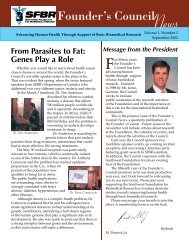
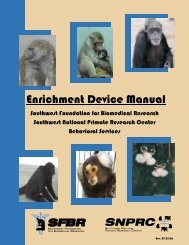
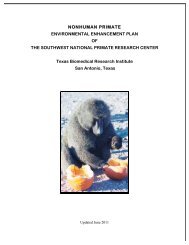
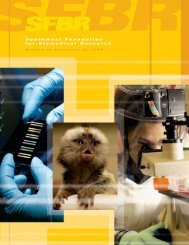
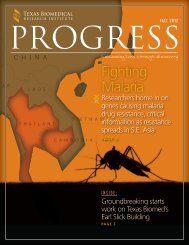
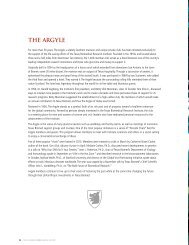
![Vol. 8 No. 2, 2011 [PDF] - Texas Biomedical Research Institute](https://img.yumpu.com/35688099/1/190x245/vol-8-no-2-2011-pdf-texas-biomedical-research-institute.jpg?quality=85)
